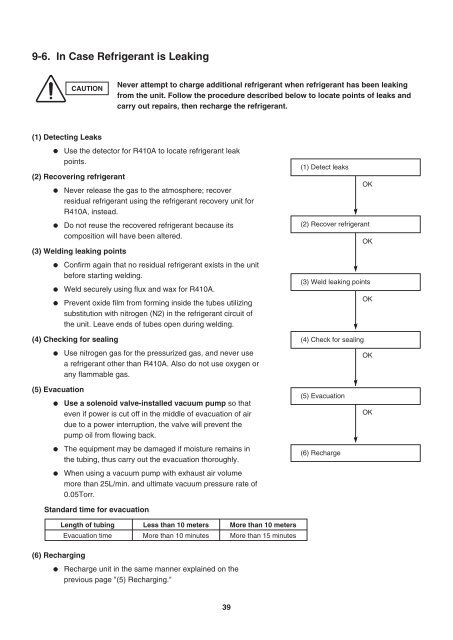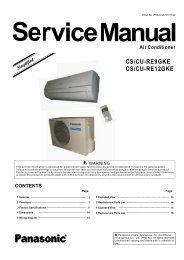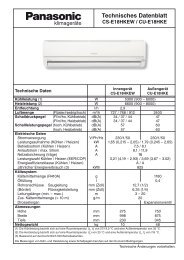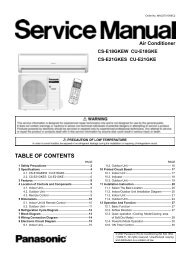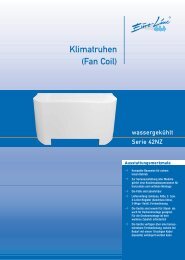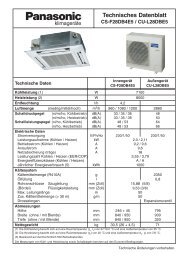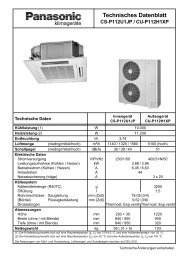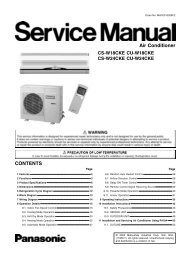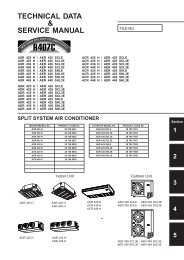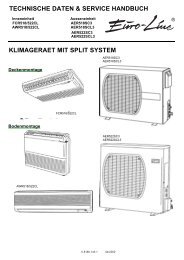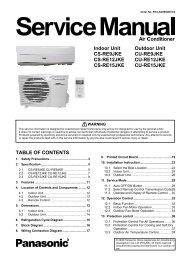technical & service manual dc inverter multi-system air conditioner
technical & service manual dc inverter multi-system air conditioner
technical & service manual dc inverter multi-system air conditioner
You also want an ePaper? Increase the reach of your titles
YUMPU automatically turns print PDFs into web optimized ePapers that Google loves.
9-6. In Case Refrigerant is Leaking<br />
CAUTION<br />
(1) Detecting Leaks<br />
Length of tubing<br />
Evacuation time<br />
Never attempt to charge additional refrigerant when refrigerant has been leaking<br />
from the unit. Follow the procedure described below to locate points of leaks and<br />
carry out rep<strong>air</strong>s, then recharge the refrigerant.<br />
Use the detector for R410A to locate refrigerant leak<br />
points.<br />
(2) Recovering refrigerant<br />
Never release the gas to the atmosphere; recover<br />
residual refrigerant using the refrigerant recovery unit for<br />
R410A, instead.<br />
Do not reuse the recovered refrigerant because its<br />
composition will have been altered.<br />
(3) Welding leaking points<br />
Confirm again that no residual refrigerant exists in the unit<br />
before starting welding.<br />
Weld securely using flux and wax for R410A.<br />
Prevent oxide film from forming inside the tubes utilizing<br />
substitution with nitrogen (N2) in the refrigerant circuit of<br />
the unit. Leave ends of tubes open during welding.<br />
(4) Checking for sealing<br />
(5) Evacuation<br />
Use nitrogen gas for the pressurized gas, and never use<br />
a refrigerant other than R410A. Also do not use oxygen or<br />
any flammable gas.<br />
Use a solenoid valve-installed vacuum pump so that<br />
even if power is cut off in the middle of evacuation of <strong>air</strong><br />
due to a power interruption, the valve will prevent the<br />
pump oil from flowing back.<br />
The equipment may be damaged if moisture remains in<br />
the tubing, thus carry out the evacuation thoroughly.<br />
When using a vacuum pump with exhaust <strong>air</strong> volume<br />
more than 25L/min. and ultimate vacuum pressure rate of<br />
0.05Torr.<br />
Standard time for evacuation<br />
(6) Recharging<br />
Less than 10 meters<br />
More than 10 minutes<br />
Recharge unit in the same manner explained on the<br />
previous page "(5) Recharging."<br />
39<br />
More than 10 meters<br />
More than 15 minutes<br />
(1) Detect leaks<br />
(2) Recover refrigerant<br />
OK<br />
(3) Weld leaking points<br />
(4) Check for sealing<br />
(5) Evacuation<br />
(6) Recharge<br />
OK<br />
OK<br />
OK<br />
OK


